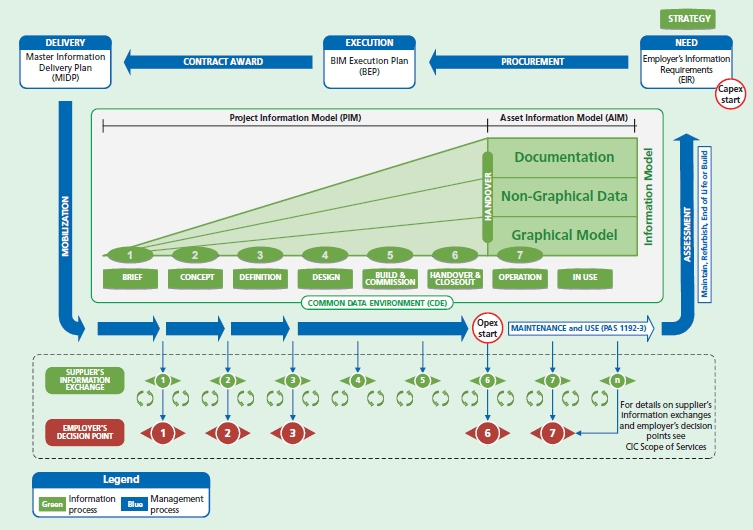PAS 1192-2 in 5 Minutes
- Youtube Views 65,785 VIDEO VIEWS
PAS 1192-2 explained in 5 minutes! PAS 1192-2 provides the framework for collaborative working and information management in a BIM Level 2 environment.
This animation brings the guidance to life and explains the key principles and process map in just 5 minutes.
Narrated by Fred Mills, The B1M. Copyright in PAS 1192-2:2013 is owned by The British Standards Institution, Mark Bew MBE and Mervyn Richards OBE.
The production of co-ordinated design and construction information is a task- and time-based process, independent of which procurement route or form of contract is used. Each task needs to be carried out in a particular order for the mutual benefit of all those involved, otherwise known as “collaborative working”.
"Information that is inaccurate, incomplete + ambiguous, can result in additional capital delivery costs of 20-25%"
In a collaborative working environment, teams are asked to produce information using standardised processes and agreed standards and methods, to ensure the same form and quality, enabling information to be used and reused without change or interpretation. If an individual, office or team changes the process without agreement, it will hinder collaboration – a participant insisting on “my standard” is not acceptable in a collaborative working environment.
This approach does not require more work, as this information has always been required to be produced. However, true collaborative working requires mutual understanding and trust within the team and a deeper level of standardised process than has previously been experienced, if the information is to be produced and delivered in a consistent timely manner. The benefits of working in this way can include fewer delays and disputes within the team, better management of project risk and better understanding of where costs are being incurred.

The Information Delivery Cycle, as seen in PAS 1192-2: 2013. © 2013 The British Standards Institution, Mark Bew MBE and Mervyn Richards OBE.
Wherever possible, lean principles should be applied to reduce the expenditure of resources for any goal other than the creation of value for the employer.
However, for the production of information to be truly lean, it is critical to understand its future use. This is achieved by “beginning with the end in mind” and identifying the downstream uses of information, to ensure it can be used and re-used throughout the project and life of the asset.
It is anticipated that PAS 1192-2 is of equal value to small practices as well as large multi-nationals. The impact of poor information management and waste is potentially equal on all projects. Where appropriate we have offered some advice as to how the process and methods described here can be implemented in a scalable fashion to suit all organisations.
"Beginning with the end in mind"
The UK Government Construction Strategy seeks to reduce the cost of public sector assets by up to 20% by 2016. The strategy calls “for a profound change in the relationship between public authorities and the construction industry to ensure the Government consistently gets a good deal and the country gets the social and economic infrastructure it needs for the long-term”.
Basic problems exist with procuring public assets, which have been known for over 100 years, but little as yet has been achieved in resolving them.
The Construction Strategy defines a number of strategic objectives, which collectively will overcome these problems. In particular, a strategic objective has been set to achieve maturity Level 2 building information modelling (BIM) on all public sector asset procurement, with equal applicability to private sector building, infrastructure, refurbishment and new-build projects. This will address the problem of information that is inaccurate, incomplete and ambiguous and results in unnecessary additional capital delivery costs amounting to 20-25%.
It was envisaged that the advent of Computer Aided Design (CAD) solutions had the potential to improve the consistency of information, but at best it has only served to perpetuate the problem.
This additional 20-25% is considered waste and can be reduced if the standards, processes and procedures outlined in BS 1192:2007 and this document are implemented.
The process of BIM generates information models and their associated information that are used throughout the lifecycle of building/infrastructure facilities or assets. The information delivery and project management cycle (captured in The B1M video above) shows in blue the generic process of identifying a project need (which may be for design services, for construction or for supply of goods), procuring and awarding a contract, mobilising a supplier and generating production information and asset information relevant to the need. This cycle is followed for every aspect of a project, including the refinement of design information through the seven project stages shown in green.
The green elements represent the information delivery process known as the common data environment (CDE).
PAS 1192-3 offers guidance on the use and maintenance of the asset information model (AIM) to support the planned preventative maintenance programme and the portfolio management activity for the life of the asset.
PAS 1192-2 provides specific guidance for the information management requirements associated with projects delivered using BIM. Not all information on a project will be originated, exchanged or managed in a BIM format. This information will also need to be managed in a consistent and structured way to enable efficient and accurate information exchange. BS 1192:2007 provides details of the standards and processes that should be adopted to deliver these outcomes. Only information exchanges specific to BIM are described in PAS 1192-2.
Download a free copy of PAS 1192-2 here: http://shop.bsigroup.com/forms/PASs/PAS-1192-2/
We welcome you sharing our content to inspire others, but please be nice and play by our rules: http://www.TheB1M.com/Guidelines-for-Sharing








